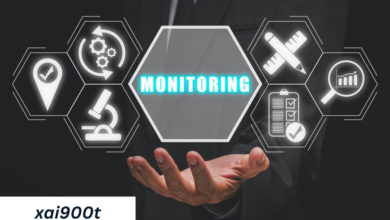Understanding IP Addresses: A Deep Dive into 185.63.253.300

In the digital age, IP addresses serve as the backbone of internet communication, allowing devices to connect, share data, and access online services. One such IP address, 185.63.253.300, may appear to be a standard numerical label, but it holds significance in networking discussions. However, upon closer inspection, this particular IP address raises questions due to its unusual format. This article will explore the structure of IP addresses, the validity of 185.63.253.300, its potential uses, and common misconceptions. We will also address frequently asked questions to provide a comprehensive understanding of how IP addresses function in modern networking.
What Is an IP Address?
An Internet Protocol (IP) address is a unique numerical identifier assigned to every device connected to a network. It enables communication between computers, servers, and other internet-enabled devices by ensuring data reaches the correct destination. IP addresses come in two primary versions: IPv4 (Internet Protocol version 4) and IPv6 (Internet Protocol version 6).
IPv4 addresses consist of four octets separated by periods, such as 192.168.1.1, with each octet ranging from 0 to 255. This format allows for approximately 4.3 billion unique addresses. However, due to the exponential growth of internet-connected devices, IPv6 was introduced, offering a significantly larger address space with a more complex structure.
The IP address 185.63.253.300 appears to follow the IPv4 format, but its last octet (300) exceeds the maximum allowable value of 255, making it an invalid address. This raises important questions about IP address validation, potential errors in documentation, and how such addresses are handled in networking environments.
Is 185.63.253.300 a Valid IP Address?
No, 185.63.253.300 is not a valid IPv4 address. As per the IPv4 addressing rules, each octet must be a number between 0 and 255. The last segment of this address (300) exceeds this limit, rendering it invalid.
Why Would Someone Use an Invalid IP Like 185.63.253.300?
There are several reasons why an invalid IP address might appear in documentation or discussions:
- Typographical Errors – A simple mistake in typing or transcribing an IP address could lead to an invalid format. The correct address might be 185.63.253.30 or 185.63.253.200, but an extra zero was accidentally added.
- Placeholder in Examples – Some technical guides or tutorials use intentionally incorrect IPs to demonstrate error handling or validation techniques.
- Malicious Spoofing Attempts – Cyber attackers sometimes use malformed IP addresses in phishing schemes or network probing to bypass security measures.
- Fictional or Reserved Addresses – In some cases, invalid IPs are used in fictional scenarios, such as movies or books, where a realistic but non-functional address is needed.
Understanding why an IP like 185.63.253.300 is invalid helps network administrators and developers enforce proper IP validation in their systems.
How Are IP Addresses Assigned and Managed?
IP addresses are distributed and managed by organizations such as the Internet Assigned Numbers Authority (IANA) and regional internet registries (RIRs) like ARIN, RIPE NCC, and APNIC. These entities allocate IP blocks to internet service providers (ISPs), corporations, and other entities that require public IP addresses.
Public vs. Private IP Addresses
- Public IPs are routable on the internet and are used by servers, websites, and other publicly accessible services.
- Private IPs (e.g., 192.168.x.x, 10.x.x.x, 172.16.x.x) are used within local networks (LANs) and are not directly accessible from the internet.
Since 185.63.253.300 is invalid, it cannot be assigned as either a public or private address. However, if corrected to a valid format (e.g., 185.63.253.30), it could belong to a legitimate network range.
Common Misconceptions About IP Addresses
Many people misunderstand how IP addresses work, leading to confusion about their structure and usage. Below are some common myths:
Myth 1: All Numbers in an IP Address Can Go Up to 999
As previously explained, each octet in an IPv4 address can only range from 0 to 255. Any number outside this range (like 300) makes the address invalid.
Myth 2: IP Addresses Reveal Exact Physical Locations
While IP geolocation can approximate a user’s location (city or country), it does not provide precise street addresses unless combined with additional data from ISPs.
Myth 3: Changing Your IP Address Makes You Completely Anonymous
While using a VPN or proxy can mask your public IP, other tracking methods (cookies, browser fingerprints, and account logins) can still identify users.
Myth 4: All IP Addresses Are Permanent
Most home users receive dynamic IPs from their ISPs, meaning their public IP can change periodically. Only businesses and servers typically use static (permanent) IPs.

Conclusion
The IP address 185.63.253.300 serves as an interesting case study in understanding IPv4 addressing rules. While it appears structurally similar to a valid IP, its last octet exceeds the permissible limit, making it non-functional in real-world networking. This example highlights the importance of proper IP validation in software development, cybersecurity, and network administration.
By learning how IP addresses are structured, assigned, and validated, users can better troubleshoot connectivity issues, enhance security measures, and avoid common misconceptions. Whether you’re a network engineer, developer, or casual internet user, understanding IP addressing is essential in today’s connected world.
Frequently Asked Questions (FAQs)
1. Why is 185.63.253.300 an invalid IP address?
Because the last octet (300) exceeds the maximum value of 255 allowed in IPv4 addressing.
2. What is the correct format for an IPv4 address?
An IPv4 address consists of four numbers between 0 and 255, separated by dots (e.g., 192.168.1.1).
3. Can an invalid IP like 185.63.253.300 cause security risks?
Yes, if a system fails to validate IP formats properly, attackers might exploit this weakness in phishing or injection attacks.
4. How can I check if an IP address is valid?
You can use online IP validation tools or write a script that checks if each octet is between 0 and 255.
5. What is the difference between IPv4 and IPv6?
IPv4 uses 32-bit addresses (e.g., 192.168.1.1), while IPv6 uses 128-bit hexadecimal addresses (e.g., 2001:0db8:85a3::8a2e:0370:7334) to accommodate more devices.
6. Can two devices have the same IP address?
No, each device on a network must have a unique IP to avoid conflicts, though private IPs can be reused in different local networks.



